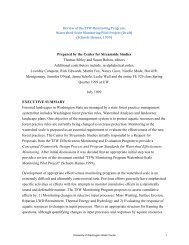Copyright 2012 Aileen M. Echiverri-Cohen - University of Washington
Copyright 2012 Aileen M. Echiverri-Cohen - University of Washington
Copyright 2012 Aileen M. Echiverri-Cohen - University of Washington
You also want an ePaper? Increase the reach of your titles
YUMPU automatically turns print PDFs into web optimized ePapers that Google loves.
Likelihood index as it corrects the -2 Restricted Log Liklihood for small sample sizes like in the<br />
present study (Fields, 2001). A random intercept, fixed slopes model specified a covariance<br />
structure <strong>of</strong> variable components, as is <strong>of</strong>ten the result <strong>of</strong> small sample size and small number <strong>of</strong><br />
repeated measures per participant or small levels <strong>of</strong> variance (Gallop & Tasca, 2009). Restricted<br />
maximum likelihood (REML) was used as it yields unbiased estimates <strong>of</strong> the random effects<br />
variances (Twisk, 2006).<br />
The best-fitting model for treatment modality, time, and AB was a random intercept<br />
model. This was evaluated by fitting nested structures <strong>of</strong> the most complex covariance structure<br />
for multilevel models, where the specified random effect, (i.e., random intercept and random<br />
slope) using an unstructured covariance design with random intercept and random slope terms,<br />
were allowed to be correlated. The correlated random terms accounts for a possible relationship<br />
between where an individual starts and their rate <strong>of</strong> change. If the correlation is not significantly<br />
different from zero, under parsimony, then the next less complex structure using a variance<br />
components structure was fitted to the model where the correlation <strong>of</strong> the random intercept and<br />
random slope term was set to 0. This structure allows for subject-to-subject variability in their<br />
group average intercept and group average slope but assumes where a person starts is<br />
independent <strong>of</strong> how they change. If there is not sufficient subject-to-subject variability in rate <strong>of</strong><br />
change, the parsimonious structure is the least complex structure corresponding to a random<br />
intercept model. Under the random intercept model, the covariance structure between the<br />
repeated measures is modeled as a compound symmetry structure which is analogous to the<br />
simplistic repeated measures ANOVA model for clustered data. Guidelines in assessing the<br />
parsimonious covariance structure for the random effects terms was based on Gallop and Tasca<br />
(2009).<br />
32
















